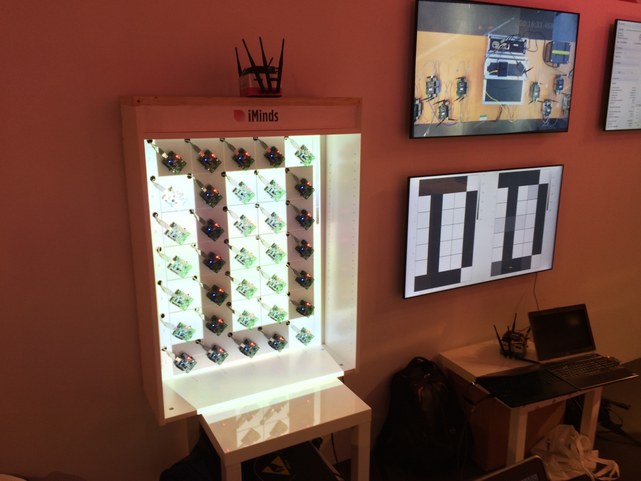AppDaptive IoT Networks
By 2020, it is expected that over 50 billions devices will be connected to the Internet, forming what is being called the Internet of Things, unlocking a wide variety of IoT applications.
Until recently, existing wireless communication solutions for IoT devices were either targeting very specific use cases or were one-size-fits-all. However, both approaches fail to address the wide heterogeneity of IoT applications and corresponding requirements. In response, both research and standardization efforts now focus on the realization of novel, more open, flexible and configurable wireless solutions that, if properly configured, can meet a wide variety of requirements (e.g. IEEE 802.15.4, TDMA-based Wi-Fi).
A second important trend that can be observed is the significant rise in research activities that explore the adoption of open Internet and Web technologies (e.g. CoAP-based web services, discovery mechanisms, open data formats), thereby stepping away from less flexible standards. This ongoing adoption of open IoT technologies, results in more flexible, diverse, distributed and reconfigurable IoT-based applications running on top of a shared wireless infrastructure.
Consequently, today’s IoT systems are evolving upon communication technologies with flexible, reconfigurable lower layers in combination with extreme flexibility at the higher layers. In such systems, changes at the higher layers must result in optimal automated reconfigurations at the lower layers. The concept of AppDaptive IoT networks captures this challenge and strives to build IoT networks that are automatically being reconfigured when changes at the higher-layer IoT applications occur. For this, we leverage on our state-of-the-art research across the entire (embedded) networking stack, from the MAC layer up to the application layer.
IDLab performs cutting edge research on the following topics to realize this novel concept:
- Automatic and run-time recognition of standard-based (focus on CoAP) IoT application dynamics and translation of the discovered application layer info into concrete network requirements.
- Provisioning and identification of flexible points in the underlying network protocol stack for reconfiguration.
- Provisioning of QoS resources along each path in the wireless network. the ability to provide differentiated resource provisioning, dependent on the application requirements.
- Design of lightweight network monitoring mechanisms to maintain an up-to-date view on current network state.
- Intelligence to turn network requirements and network state into actionable network reconfigurations, including smart scheduling mechanisms for reservation-based networking technologies (TSCH / TDMA-based Wi-Fi).
Staff
Chris Blondia, Eli De Poorter, Jeroen Famaey, Jeroen Hoebeke, Steen Latré, Ingrid Moerman
Researchers
Jan Bauwens, Bart Braem, Enri Dalipi, Glenn Daneels, Glenn Ergeerts, Abdulkadir Karaagac, Esteban Municio, Jen Rossey, Peter Ruckebusch, Le Tian, Floris Van den Abeele, Daniel Van den Akker
Projects
- H2020 WiSHFUL: Wireless Software and Hardware platforms for Flexible and Unified radio and network controL
- H2020 eWINE: elastic Wireless Networking Experimentation
- ICON HYCOWARE: Hybrid Connected Warehouses
- ICON MoniCow: More Efficient Cattle Monitoring Through an Advanced Data System
- FWO/SBO SAMURAI: Software Architecture and Modules for Unified RAdIo control
- GOA Disposable and biodegradable wireless networks for extreme conditions
Key publications
- Girum K. Teklemariam, Floris Van den Abeele, Ingrid Moerman, Piet Demeester, and Jeroen Hoebeke, "Bindings and RESTlets: a novel set of CoAP-based application enablers to build IoT applications", Sensors 2016, 16(8), 1217; doi:10.3390/s16081217
- Bart Jooris, Jan Bauwens, Peter Ruckebusch, Peter De Valck, Christophe Van Praet, Ingrid Moerman, Eli De Poorter, "TAISC: a cross-platform MAC protocol compiler and execution engine", Computer Networks, doi:10.1016/j.comnet.2016.03.027 (2016)
- Esteban Municio, Steven Latré, “Decentralized Broadcast-based Scheduling for Dense Multi-hop TSCH Networks”, MobiArch - MobiCom workshop (2016)
- Isam Ishaq, David Carels, Girum K. Teklemariam, Jeroen Hoebeke, Floris Van den Abeele, Eli De Poorter, Ingrid Moerman and Piet Demeester, “IETF Standardization in the Field of Internet of Things (IoT): A Survey”, Journal of Sensors and Actuator Networks, 2(2), 2013, pp. 235-287, doi:10.3390/jsan2020235
- Ruckebusch, P., De Poorter, E., Fortuna, C., & Moerman, I. (2016). GITAR: Generic extension for Internet-of-Things ARchitectures enabling dynamic updates of network and application modules. Ad Hoc Networks, Volume 36, Part 1, January 2016, Pages 127–151

